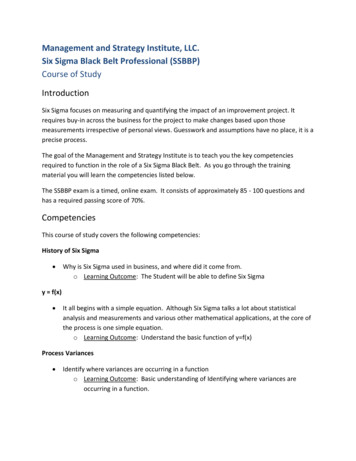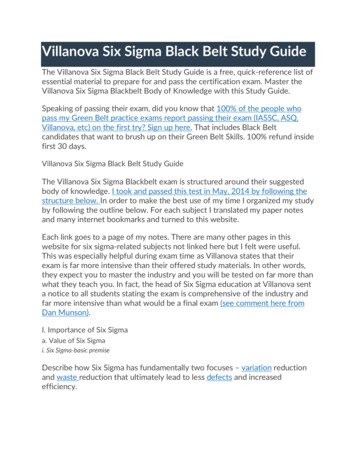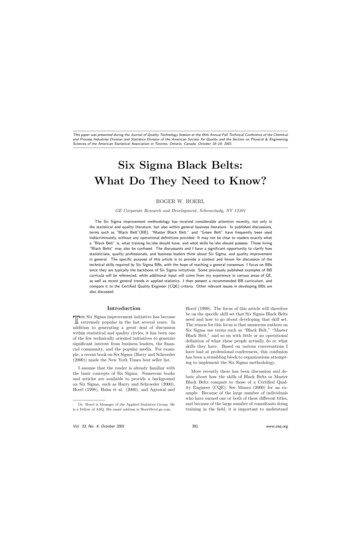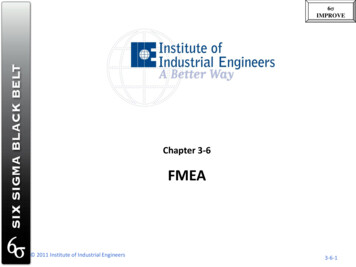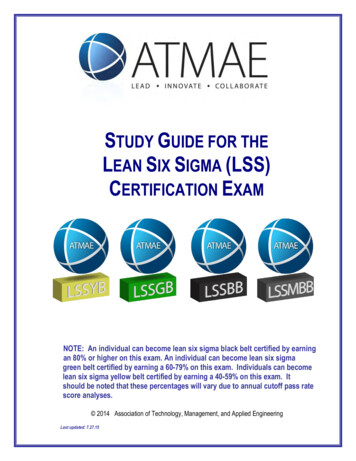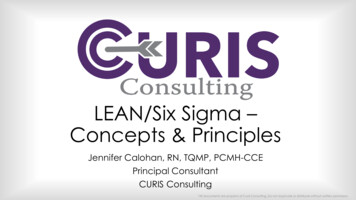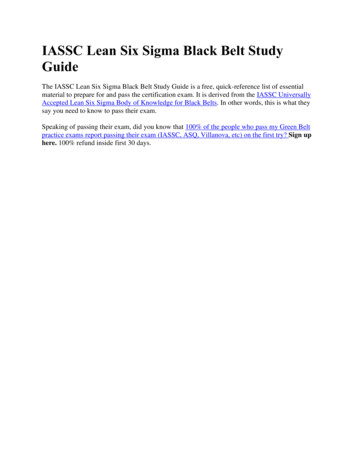
Transcription
IASSC Lean Six Sigma Black Belt StudyGuideThe IASSC Lean Six Sigma Black Belt Study Guide is a free, quick-reference list of essentialmaterial to prepare for and pass the certification exam. It is derived from the IASSC UniversallyAccepted Lean Six Sigma Body of Knowledge for Black Belts. In other words, this is what theysay you need to know to pass their exam.Speaking of passing their exam, did you know that 100% of the people who pass my Green Beltpractice exams report passing their exam (IASSC, ASQ, Villanova, etc) on the first try? Sign uphere. 100% refund inside first 30 days.
1.0 Define Phase1.1 The Basics of Six Sigma1.1.1 Meanings of Six Sigma1.1.2 General History of Six Sigma & Continuous Improvement1.1.3 Deliverables of a Lean Six Sigma Project1.1.4 The Problem Solving Strategy Y f(x)1.1.5 Voice of the Customer, Business and Employee1.1.6 Six Sigma Roles & Responsibilities1.2 The Fundamentals of Six Sigma1.2.1 Defining a Process Process Mapo Sub-process mapSIPOC1.2.2 Critical to Quality Characteristics (CTQ’s)1.2.3 Cost of Poor Quality (COPQ)1.2.4 Pareto Analysis (80:20 rule)1.2.5 Basic Six Sigma Metricsa. including DPU, DPMO, FTY, RTY Cycle Time, deriving these metrics .1.3 Selecting Lean Six Sigma Projects1.3.1 Building a Business Case & Project Charter1.3.2 Developing Project Metrics1.3.3 Financial Evaluation & Benefits Capture
1.4 The Lean Enterprise1.4.1 Understanding Lean1.4.2 The History of Lean1.4.3 Lean & Six Sigma1.4.4 The Seven Elements of Wastea. Overproduction, Correction, Inventory, Motion, Overprocessing, Conveyance, Waiting.1.4.5 5Sa. Straighten, Shine, Standardize, Self-Discipline, Sort
2.0 Measure Phase2.1 Process Definition2.1.1 Cause & Effect / Fishbone Diagrams2.1.2 Process Mapping, SIPOC, Value Stream Map2.1.3 X-Y Diagram2.1.4 Failure Modes & Effects Analysis (FMEA)2.2 Six Sigma Statistics2.2.1 Basic Statistics2.2.2 Descriptive Statistics2.2.3 Normal Distributions & Normality2.2.4 Graphical Analysis2.3 Measurement System Analysis2.3.1 Precision & Accuracy2.3.2 Bias, Linearity & Stability2.3.3 Gage Repeatability & Reproducibility2.3.4 Variable & Attribute MSA2.4 Process Capability2.4.1 Capability Analysis2.4.2 Concept of Stability2.4.3 Attribute & Discrete Capability2.4.4 Monitoring Techniques
3.0 Analyze Phase3.1 Patterns of Variation3.1.1 Multi-Vari Analysis3.1.2 Classes of Distributions3.2 Inferential Statistics3.2.1 Understanding Inference3.2.2 Sampling Techniques & UsesData SamplingSampling with replacementSampling without replacement3.2.3 Central Limit Theorem3.3 Hypothesis Testing3.3.1 General Concepts & Goals of Hypothesis Testing3.3.2 Significance; Practical vs. Statistical3.3.3 Risk; Alpha & Beta3.3.4 Types of Hypothesis Test3.4 Hypothesis Testing with Normal Data3.4.1 1 & 2 sample t-tests3.4.2 1 sample variance3.4.3 One Way ANOVAa. Including Tests of Equal Variance, Normality Testing and Sample Size calculation,performing tests and interpreting results.
3.5 Hypothesis Testing with Non-Normal Data3.5.1 Mann-Whitney3.5.2 Kruskal-Wallis3.5.3 Mood’s Median3.5.4 Friedman3.5.5 1 Sample Sign3.5.6 1 Sample Wilcoxon3.5.7 One and Two Sample Proportion3.5.8 Chi-Squared (Contingency Tables)a. Including Tests of Equal Variance, Normality Testing and Sample Size calculation,performing tests and interpreting results.4.0 Improve Phase4.1 Simple Linear Regression4.1.1 Correlation4.1.2 Regression Equations4.1.3 Residuals Analysis4.2 Multiple Regression Analysis4.2.1 Non- Linear Regression4.2.2 Multiple Linear Regression4.2.3 Confidence & Prediction Intervals4.2.4 Residuals Analysis4.2.5 Data Transformation, Box Cox
4.3 Designed Experiments4.3.1 Experiment Objectives4.3.2 Experimental Methods4.3.3 Experiment Design Considerations4.4 Full Factorial Experiments4.4.1 2k Full Factorial Designs4.4.2 Linear & Quadratic Mathematical Models4.4.3 Balanced & Orthogonal Designs4.4.4 Fit, Diagnose Model and Center Points4.5 Fractional Factorial Experiments4.5.1 Designs4.5.2 Confounding Effects4.5.3 Experimental Resolution
5.0 Control Phase5.1 Lean Controls5.1.1 Control Methods for 5S5.1.2 Kanban5.1.3 Poka-Yoke (Mistake Proofing)5.2 Statistical Process Control (SPC)5.2.1 Data Collection for SPC5.2.2 I-MR Chart5.2.3 Xbar-R Chart5.2.4 Attribute Charts (U Chart, P Chart, NP Chart)5.2.7 X-S chart5.2.8 CuSum Chart5.2.9 EWMA Chart5.2.10 Control Methods5.2.11 Control Chart Anatomy5.2.12 Subgroups, Impact of Variation, Frequency of Sampling5.2.13 Center Line & Control Limit Calculations5.3 Six Sigma Control Plans5.3.1 Cost Benefit Analysis5.3.2 Elements of the Control Plan5.3.3 Elements of the Response Plan
Levels of Cognition based on Bloom’s Taxonomy – Revised(2001)These levels are from “Levels of Cognition” (from Bloom’s Taxonomy – Revised, 2001). Theyare listed in order from the least complex to the most complex.Remember: Recall or recognize terms, definitions, facts, ideas, materials, patterns, sequences,methods, principles, etc.Understand: Read and understand descriptions, communications, reports, tables, diagrams,directions, regulations, etc.Apply: Know when and how to use ideas, procedures, methods, formulas, principles, theories,etc.Analyze: Break down information into its constituent parts and recognize their relationship toone another and how they are organized; identify sublevel factors or salient data from a complexscenario.Evaluate: Make judgments about the value of proposed ideas, solutions, etc., by comparing theproposal to specific criteria or standards.Create: Put parts or elements together in such a way as to reveal a pattern or structure notclearly there before; identify which data or information from a complex set is appropriate toexamine further or from which supported conclusions can be drawn.
1.1 The Basics of Six Sigma 1.1.1 Meanings of Six Sigma 1.1.2 General History of Six Sigma & Continuous Improvement 1.1.3 Deliverables of a Lean Six Sigma Project 1.1.4 The Problem Solving Strategy Y f(x) 1.1.5 Voice of the Customer, Business and Employee 1.1.6 Six Sigma Roles & Responsibi






